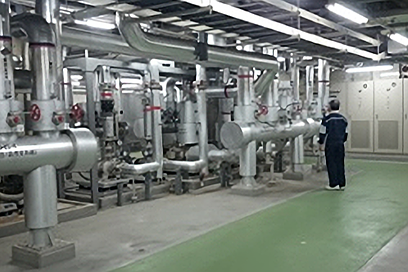
Chapter 5 Transformation
2004
2023
Section 4. Further Strengthening of the Corporate Structure and Group Reorganization
5. Integration and Reorganization of Affiliate Companies
In October 2004, Daibiru became a consolidated subsidiary of Mitsui O.S.K. Lines. Later, in July 2007, the affiliated companies were integrated and reorganized with the aim of enhancing Group management through the use of a consolidated accounting system. In 2007, Daibiru acquired 51% of MOL Kosan Co., Ltd., which had been the real estate management company for the MOL Group, and made it a Daibiru subsidiary. Daibiru then sold 100% of its shares of Kansai Tatemono Kanri and ESCA Corporation and 49% of its shares of Daibiru Facility Management, Ltd. (formerly Osaka All Service) to MOL Kosan Co., Ltd. The goal of this reorganization was to expand the business operations of the Daibiru Group by maintaining and developing the facility management expertise that Daibiru had accumulated. This would enable the company to strengthen its sales capabilities with respect to building management, to streamline administrative department costs, and to train facility-related engineers. Daibiru eventually became a wholly owned subsidiary of Mitsui O.S.K. Lines in April 2022, and this was followed by MOL Kosan and Daibiru Facility Management becoming wholly owned subsidiaries of Daibiru in June 2023.
-

Daibiru Facility Management Co., Ltd.
Kosan Kanri Service Co., Ltd. got its start as a company called Shokusan Kogyo Co., Ltd. that started providing building cleaning services in 1972 and comprehensive building management services in 1979 as an affiliate of Mitsui O.S.K. Lines. It changed its name to Hutec Service Co., Ltd. in 2000 and merged with the aforementioned ESCA Corporation in July 2008, making a fresh start as Kosan Kanri Service Co., Ltd.
Additionally, in the Kansai region, Kansai Tatemono Kanri merged with Santo Tatemono Service Co., Ltd. in November 2008 to form Kosan Kanri Service West Co., Ltd., which then took over the operations of Hutec Service Co., Ltd. in western Japan.
-
1923 1944 Beginnings
-
Section 2. Launching a Building Management Business
-
Section 4. Business Development in Wartime
-
1945 1957 Reconstruction
-
Section 2. Our Buildings Reopen
-
1958 1988 Development
-
Section 1. Expanding the Building Management Business
- 1. The End of the Requisition of the Hibiya Daibiru Buildings
- 2. Upgrading the Facilities of the Daibiru Buildings and Damage Caused by the 2nd Muroto Typhoon
- 3. The Completion of the North Wing of the Shin-Daibiru Building
- 4. The Completion of the Yaesu Daibiru Building
- 5. The Acquisition of the Midosuji Daibiru Building
- 6. The Completion of the Kojimachi Daibiru Building
- 7. The Completion of the Uchisaiwaicho Daibiru Building
- 8. The Completion of the Dojima Daibiru Building
- 9. The Completion of the Awajimachi Daibiru Building
- 10. The Completion of the Mita-Nitto Daibiru Building
-
Section 2. Expanding the Business Through M&A
-
-
1989 2003 Expansion (1989–2003)
-
Section 1. Creating New Urban Spaces
- 1. The Bubble Economy and Daibiru
- 2. The Hibiya Daibiru Rebuilding Project
- 3. The Completion of the Rebuild
- 4. The Start and Execution of Renovation Plans
- 5. The Completion of the Kita-Umeda Daibiru Building
- 6. The Completion of the Yodoyabashi Daibiru Building
- 7. The Completion of the Estate Tosabori Building
- 8. The Completion of the Umeda Daibiru Building
- 9. The Completion of Violette Takarazuka
- 10. The Shinjuku Daibiru Building and Shiba Daibiru Building Acquisitions
-
Section 2. The Development of a New Corporate Identity and a Name Change
-
Section 3. Disaster Preparedness and Risk Management
-
-
2004 2023 Transformation (2004–2023)
-
Section 1. Becoming a Consolidated Subsidiary of Mitsui O.S.K. Lines and Promoting Management Plans
- 1. Becoming a Consolidated Subsidiary of Mitsui O.S.K. Lines
- 2. Concentrating Investment in the Tokyo Area
- 3. Expanding into Other Countries and Japanese Regions
- 4. Establishing Daibiru 3D-Project Phase I, a Medium-Term Management Plan
- 5. Establishing Our Management Philosophy and Mission Statement
- 6. Establishing Daibiru-3D Project Phase II, a New Medium-Term Management Plan
- 7. Ongoing Establishment of New Medium-Term Management Plans
-
Section 2. Expanding Our Business
- 1. The Akihabara Station Redevelopment Project and the Completion of the Akihabara Daibiru Building
- 2. The Acquisition of the Toranomon Daibiru Building
- 3. The 3 Nakanoshima Joint Development Project and the Completion of the Nakanoshima Daibiru Building
- 4. The Completion of the Tosabori Daibiru Building
- 5. The Acquisition of Aoyama Rise Square
- 6. The 3 Nakanoshima Joint Development Project and the Completion of the Daibiru-Honkan Building
- 7. Rebuilding the Shin-Daibiru Building
- 8. Renovation Work
- 9. Multiple Awards
- 10. Delving into Commercial Facilities
- 11. Acquiring a Partial Interest in the Seavans South Building
- 12. Expansion to Sapporo
- 13. Selling Seven Residential Properties
- 14. Starting the Rebuild of the Midosuji Daibiru Building
- 15. Starting the Rebuild of the Yaesu Daibiru Building
-
Section 3. Overseas Business Expansion
-
Section 4. Further Strengthening of the Corporate Structure and Group Reorganization
-
Section 5. Harmonious Coexistence with Society
- 1. Developing a Compliance System
- 2. Developing an Internal Control System
- 3. Risk Management Measures
- 4. Sustainability Initiatives
- 5. Social Contribution and Cultural Support Initiatives
- 6. Environmental Initiatives
- 7. Working Style Reform Initiatives
- 8. Launching the Brand Development Project
- 9. Launching the Head Office Renovation Project
-
Section 6. Toward Our 100th Anniversary and Beyond
- 1. Becoming a Full Subsidiary of Mitsui O.S.K. Lines
- 2. Acquiring a Partial Interest in Otemachi First Square
- 3. Acquiring a Partial Interest in the Otemon Tower / ENEOS Building
- 4. Investment in an SPC for Logistics Facilities in the Nishinomiya Area
- 5. Project Participation in the United States
- 6. Project Development in Melbourne, Australia
- 7. Formulation of a New Medium- and Long-Term Management Plan
- 8. Implementing 100th Anniversary Projects
- 9. For Future Generations
-



